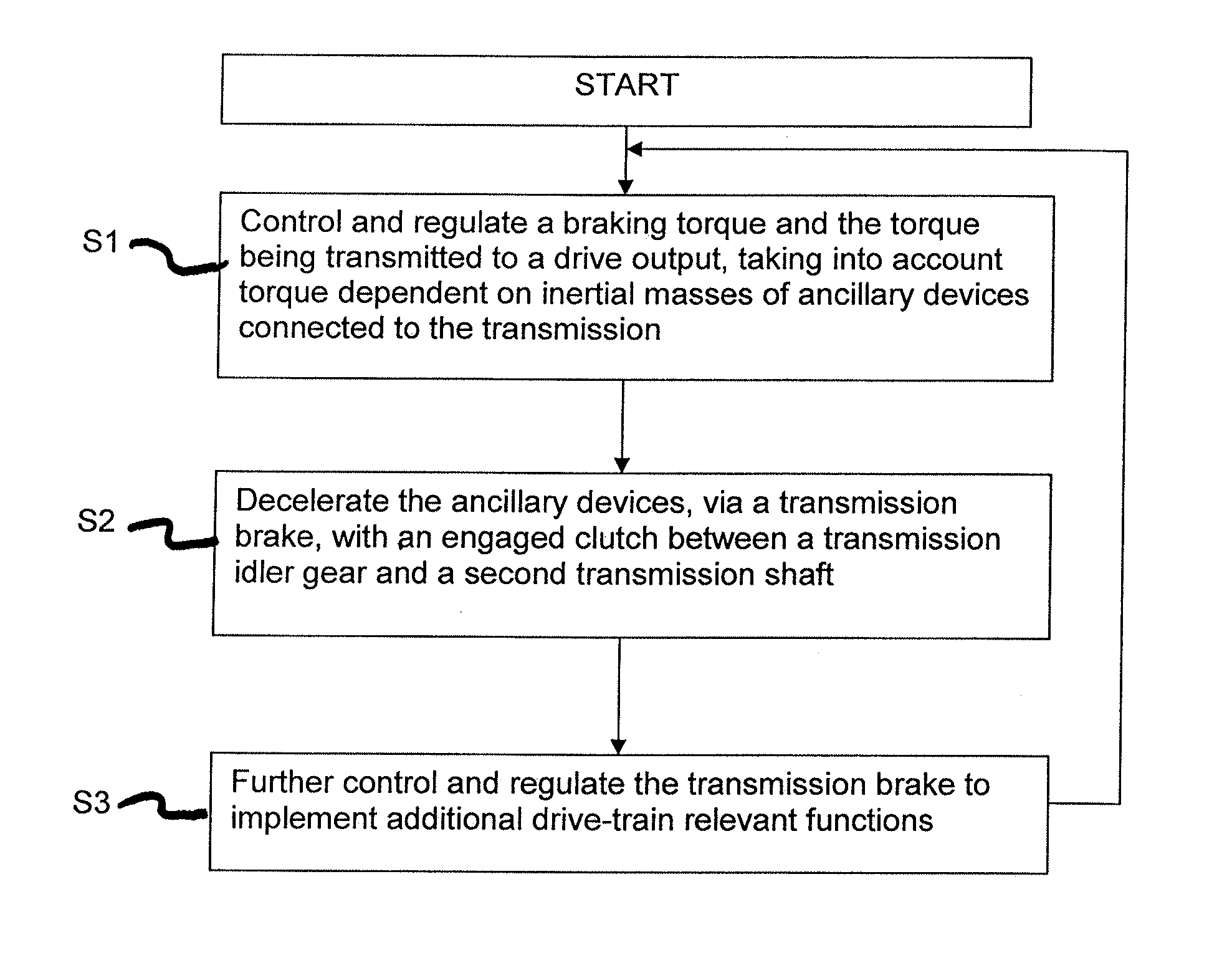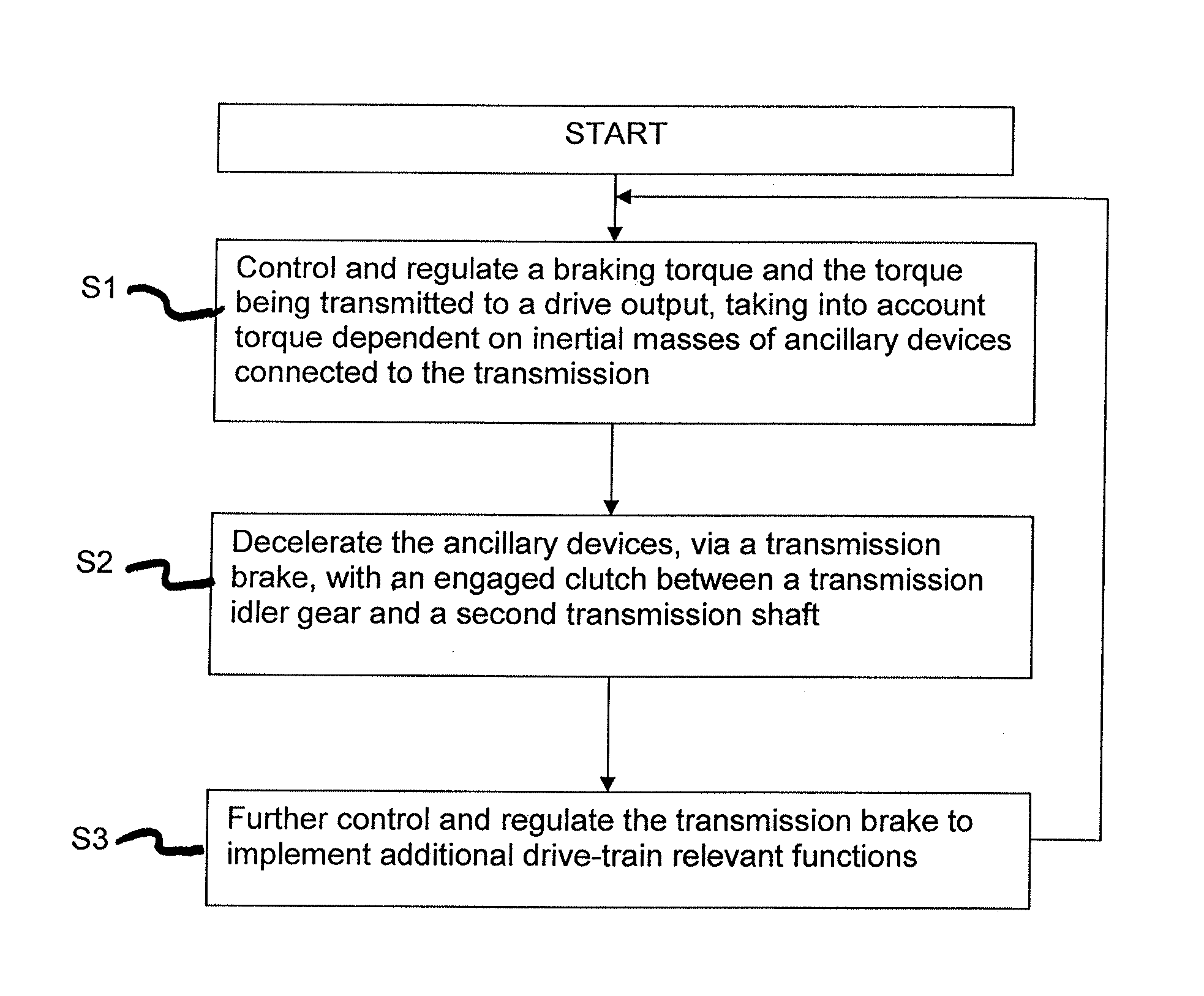Method for broadening the function of a transmission brake
a technology of transmission brake and function, which is applied in the direction of gearing control, gearing elements, clutches, etc., can solve the problems of exhausting technical possibilities, and achieve the effects of improving the comfort and speed of shifting operations, reducing hardware complexity, and broadening the functional range of transmission brakes
- Summary
- Abstract
- Description
- Claims
- Application Information
AI Technical Summary
Benefits of technology
Problems solved by technology
Method used
Image
Examples
first embodiment
[0016]In a first embodiment, the invention provides for the torque, which is conditional on the inertial masses of the ancillary drive systems connected to the gearbox, to be taken into account for the control and / or regulation of the braking torque, and that ancillary drive systems are decelerated by the transmission brake with an engaged clutch (step S2). Ancillary drive systems shall be understood here as transmission output shafts which enable the operation of units or devices by the drive motor of the motor vehicle in addition to the usual gears that act on the driving wheels of the motor vehicle. These units or devices can be intended for operation when the vehicle is at a standstill or during drive operation.
[0017]Ancillary outputs coupled to the transmission, or as the case may be, the units or devices connected to the ancillary drives, may, depending on their type and operating conditions, have considerable rotational masses, which only diminish slowly when coupled with an ...
second embodiment
[0022]In the method according to the invention, a transmission brake used to synchronize the transmission is utilized in a special mode to secure the motor vehicle against unintentional coasting.
[0023]There are many known processes and devices to prevent unintentional coasting of a stationary motor vehicle without action being taken by the driver. They usually operate with automatic control of the main brake or the emergency brake. While systems that act on the emergency brake usually require actuators that are used exclusively for this purpose, which makes the vehicle more expensive and increases the weight of the vehicle, the required actuators for systems that act on the main brake are already present in modern vehicles.
[0024]In principle, however, it is not desirable to increase the complexity of a highly safety-relevant system, such as the brake control, through additional functions. This disadvantage is avoided by using the transmission brake to secure the vehicle against coas...
third embodiment
[0028]the inventive method provides for a torque that is applied to the transmission via the main clutch to be compensated for, wholly or in part, through control of the transmission brake. It can be particularly useful, for example, when starting up, to initially intensify the torque present in the transmission, so that the vehicle is prevented from coasting backward when starting on an incline. Even when the actual torque set by the main clutch exceeds the target torque, it can be compensated for by a corresponding braking torque of the transmission brake. In the event that the torque transmitted by the main clutch is also supposed to be reduced, the transmission brake can reduce the torque applied to the output shaft of the gearbox until the main clutch is correspondingly positioned. This enables slower and thus more precise positioning of the clutch, while quickly achieving the desired torque on the output side of the transmission at the same time. An additional useful applicati...
PUM
 Login to View More
Login to View More Abstract
Description
Claims
Application Information
 Login to View More
Login to View More - R&D
- Intellectual Property
- Life Sciences
- Materials
- Tech Scout
- Unparalleled Data Quality
- Higher Quality Content
- 60% Fewer Hallucinations
Browse by: Latest US Patents, China's latest patents, Technical Efficacy Thesaurus, Application Domain, Technology Topic, Popular Technical Reports.
© 2025 PatSnap. All rights reserved.Legal|Privacy policy|Modern Slavery Act Transparency Statement|Sitemap|About US| Contact US: help@patsnap.com


